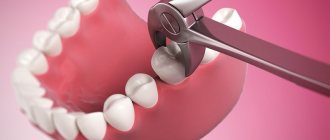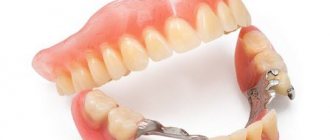Dear friends, last time we talked about what wisdom teeth are like, when they need to be removed and when not. And today I will tell you in detail and in every detail how the removal of “sentenced” teeth actually takes place. With pictures. Therefore, I recommend that especially impressionable people and pregnant women press the “Ctrl +” key combination. Joke.
Where does the removal of the 8th, and, in principle, any other tooth begin?
With anesthesia.
So:
Anesthesia (pain relief)
To minimize discomfort during an injection, you need to treat the injection site with a special anesthetic gel. This is the so-called topical anesthesia. It is very often used in pediatric dentistry, but we also use it in working with adults. As practice shows, there are fewer unpleasant sensations, and the taste is pleasant... at least some kind of joy.
When removing teeth from the upper jaw, as a rule, a simple infiltration of anesthetic into the area of the tooth being removed is sufficient. It is carried out using a special syringe with specially selected anesthetics and is called infiltration .
When removing teeth on the lower jaw, infiltration anesthesia is usually not enough (with the exception of the frontal group of teeth, from canine to canine). Therefore, the anesthesia technique changes somewhat - the anesthetic, using a long but very thin needle, is applied directly to the nerve bundle responsible for the innervation of the desired areas. This anesthesia allows you to “turn off” sensitivity not only in the area of the tooth being removed, but also in the lip, chin, part of the tongue, etc.
It should be noted that during and immediately after anesthesia, a number of interesting phenomena may be observed - increased heart rate, trembling of limbs, an inexplicable feeling of anxiety. Many patients begin to panic about this. But there is no need to panic! These are side effects of most modern anesthetics and go away on their own within 10-15 minutes.
Well, the anesthesia is done! Now you need to make sure that it was carried out successfully?
Those places that should ideally be numb are listed above. Also, using a special instrument and pressing on the gum in the area of the operated tooth, we determine whether the pain still remains or no longer exists. The only thing that should be felt is the sensation of “something” touching the gum. That is, tactile sensations are still preserved, but pain is no longer present.
And then our actions differ depending on what type of wisdom tooth we are dealing with.
What instruments are used to remove teeth?
Depending on the clinical situation, the instruments used to remove teeth may be needed in different combinations, or the doctor may be content with just one.
1) Tooth extraction forceps
- There are forceps for removing upper and lower, front and back teeth. In addition, there are so-called universal (button) dental forceps for extracting any tooth. For third molars, which are displaced towards the tongue or cheek during eruption, there are special forceps for removing wisdom teeth, which allow you to very tightly cover the crown part of the eighth teeth. There are also special root forceps for removing only one root from the bone tissue.
Deputy Chief physician Sergey Evgenievich Brodsky
Sign up for a free consultation
+7
2) Elevators for dental extraction
- This type of tool is made in the form of a sharpened screwdriver with a groove, with which you can pick up and dislocate a tooth or a separate tooth root. There are a great many options and types of dental elevators. For wisdom teeth, there is a special elevator, the so-called “Lecluse Key,” which facilitates the dislocation of eighth teeth that are tightly seated in the jaw.
Impacted wisdom tooth
These are usually the hardest eights to remove out of all the others. We have already numbed the surgical field. What's next?
It's under the gum! So, we take a scalpel in our hands and make a delicate incision in the area of the tooth being removed. This creates access to the wisdom tooth being removed. It is isolated from the surrounding tissues using special instruments, and now we can visually assess its position and choose a removal technique.
If the tooth does not erupt, it means that something is preventing it. This “something” will also interfere with its removal, and this “something” could be a neighboring tooth, a bony protrusion, etc. However, you won’t also remove the seven to get to the wisdom tooth, right?
Special surgical tip for removing wisdom teeth. Rotates at the right frequency, provides the right torque, does not burn tissue or inflate emphysema. In surgery, we use only such devices.
Therefore, we divide the tooth into parts. Using a special tip with a cutter speed of 150,000 rpm - this is no longer a simple angle cutter, but not yet a turbine cutter. The latter, by the way, is highly undesirable to use for removing teeth, because at 500,000 rpm it is easy to burn everything with a hellish flame, and with air from the cooling nozzle you can also inflate emphysema over half your face. In general, for removal you need to choose the right tools; there are no trifles or compromises here and cannot be. And you should think a hundred times before removing such problematic teeth in a one-chair dental office at a rural club on the “Half-Empty Bins” collective farm.
Impacted teeth are removed mainly with an elevator, and not with forceps, as many are accustomed to thinking
So, we divide the tooth into 2-3 parts in order to remove it carefully and with little trauma to the surrounding tissues. And teeth are usually removed using an “elevator” (in the picture on the left). Forceps, which everyone associates with removal, are actually used extremely rarely.
Well, the tooth has been removed. Next, we clean the tooth socket from “sawdust” and small tooth fragments that might remain. Using a curette.
When removing wisdom teeth, no biomaterials are used; the hole is filled with a blood clot on its own, this is quite enough for normal healing.
Moreover, “pushing” biomaterials into the hole can complicate the healing process, so let the regeneration process take place naturally and simply, and not fancy, as some doctors suggest.
After removal, resorbable (absorbable) sutures are placed on the hole; most often they do not need to be removed.
The clot is in place. Next, we bring the edges of the wound together and put stitches so that food doesn’t get stuck in the wound, it doesn’t bleed too much, and it heals faster. But at the same time, the sutures should not be tight, because the wound may bleed significantly during the first 24 hours. And if you don’t create an outflow, edema often develops.
Tooth root removal
Tooth extraction can be of varying complexity. Sometimes this is a fairly simple process, but it can get complicated:
- after the start of the procedure for removing a heavily damaged tooth or a tooth with curved roots, a fracture occurs in the middle part of the root or its apex;
- It is not easy to remove the roots of a completely destroyed tooth, which are located deep in the alveolus.
Therefore, the removal method is selected individually, depending on the situation.
Removal with forceps
A part of the tooth protrudes above the edge of the hole from the outside and inside, which the dentist must grab with forceps. To do this, he carefully separates the gum from the root.
Sometimes the dentist has to peel off the mucous membrane and periosteum from the edge of the socket in order to properly grasp the tooth.
Even if, as a result of pathological changes, bone resorption has occurred, the cheeks of the forceps can be inserted deep enough to tightly grasp the root.
Upper jaw root removal
Depending on which tooth needs to be removed, the doctor uses special extraction forceps. For example, for large molars, bayonet-shaped forceps are used. Their cheeks may move deep under the gums. Incisors and canines are removed using an S-shaped instrument.
Basically, removal occurs using rocking movements. If the roots are located deep in the alveolus or are large, the dentist adds rotational movements.
If it is not possible to extract the root with forceps due to its deviation or the thick walls of the holes, then the doctor separates them with a bur.
If the root is deviated, the bottom of the tooth cavity is sawed where the buccal roots connect to the palatal roots. First, using a spherical bur, a hole is made in the interroot commissure, and then, using a fussur bur, the bottom of the tooth is sawed in the longitudinal direction. An elevator is inserted into the resulting cavity and the palatal root is dislocated. After this, it is removed with bayonet-shaped forceps.
Mandibular root removal
Typically, the roots of the lower jaw teeth are shorter and have thinner socket walls.
To remove the root of a lower jaw tooth, a dental surgeon mainly uses rib-curved forceps with thin and narrow cheeks.
To remove fangs, use forceps with wider cheeks. Sometimes difficulties arise when extracting the lower molars. Often it is not possible to insert the cheeks of the forceps deeply because they slip off. Since the alveolar process is quite thick at the edges of the socket, it is not possible to apply forceps to the cheeks. Therefore, when removing lower molars, an elevator is often used.
Tooth root removal using an elevator
If it is not possible to remove the roots of the teeth using forceps, an elevator is used. This situation may arise if they are deep in the hole. Using forceps can damage adjacent bone tissue and mucous membrane. Using an elevator is less traumatic.
Removal by direct elevator
It is used to remove the upper teeth and roots of teeth that are located outside the dentition, and sometimes when extracting the lower third molar.
The elevator is inserted between the wall of the hole and the root that needs to be removed. To do this, the convex part of the cheek is located towards the wall of the hole, and the concave part is facing the root. The dental surgeon presses on the handle and rotates it around the longitudinal axis in both directions. Periodontal fibers break and move to the opposite wall of the socket. After the cheek of the elevator enters approximately four millimeters, the tool rests on the edge of the hole and acts as a lever. The doctor’s force is transferred to the end of the elevator, and the root is squeezed out of the alveoli.
When removing the roots of molars that are welded together, they are first separated using a fissure bur and then removed one by one using bayonet-shaped forceps or an elevator.
Removal by corner elevator
Angled elevators are used to extract the roots of lower teeth, mainly molars. When removing them, hold the tool with your whole hand. In this case, the handle of the instrument should be on the cheek side.
The cheek of the corner elevator is inserted to the tooth to be removed with its concave part into the gap between the wall of the socket and the root or between the adjacent tooth and the root. In order for the cheek to move deeper, the thumb of the left hand presses on the intermediate part of the instrument at the point where it passes into the working part. At the same time, the elevator handle is moved forward and backward alternately by twenty degrees. After inserting approximately 0.6 centimeters into the periodontal fissure, rotational movements are made with the handle and the tooth is pulled out of the socket.
Treatment of the tooth socket
If the removal took place against the background of purulent inflammation, then treatment of the tooth socket is necessary. The hole must be washed with an antiseptic solution, and then an anti-inflammatory medicine is placed in it. It should be placed in the hole even if there is no inflammation. This is done for preventive purposes, so that after removal the wounds heal without inflammatory processes.
Stitching
To bring the edges of the wound closer together, they are sutured with special suture material.
After detachment with a trowel, the gums loosen a little, and a blood clot may fall out of the socket. To prevent this from happening, the wound is sutured. In addition, this will allow it to heal faster.
Thanks to the sutures, the size of the wound is reduced, and this reduces the possibility of inflammation developing in the hole.
Sutures are also used to stop bleeding. They help prevent bleeding that may occur some time after tooth extraction.
The stitches are removed after about five to ten days. If catgut was used as a suture material, then there is no need to remove the sutures, since catgut is absorbed.
After the extraction, the dental surgeon ends his appointment with care tips and, if necessary, prescription of medications.
The article used materials from the site: https://stoma.guru/lechenie/udalenie/osobennosti-udaleniya-kornya-zuba-kak-prohodit-operaciya.html#hcq=FmBUKCq
Semi-retinated tooth
In principle, the method of removing such a tooth is no different from removing a completely impacted tooth. But, as a rule, it is a little easier, because the tooth is not so deep. The main stages are essentially the same: anesthesia, creating access to the tooth (and sometimes you can do without incisions), fragmentation (dividing the tooth into parts) and, in fact, removing the teeth in parts.
After removing the lower semi-impacted tooth, sutures are placed on the socket; in the area of the upper wisdom teeth, sutures are not necessary.
When is complex tooth extraction indicated?
Tooth extraction is considered difficult due to tumor or edema, periodontitis, periodontitis, abscess and gumboil. The presence of a cyst and a fistulous tract in the tooth also complicates the removal procedure. Impacted (unerupted) teeth are also indications for surgical tooth extraction. Complex cases include the removal of a dystopic wisdom tooth located outside the dentition; removal of 4 teeth to correct malocclusion; removal of baby teeth in children at an early age. Severe curvature of the roots and fracture of the apical part of the root are also indications for surgery. Please note that complex tooth extraction is not performed during pregnancy.
The method in which your tooth will be removed depends on the individual case. Only a specialist can determine the removal strategy. In any case, you should not be afraid of this procedure. A competent doctor will perform the removal correctly, and all you have to do is say “thank you”
Dystopic tooth
Removing such teeth can be called a simpler case compared to others, but only if the tooth has one straight root. Then the removal can take place quite quickly. But such clinical cases are extremely rare. And, looking at the picture, we see hooks, not roots, which, with proper pressure, can simply break. There are usually 2 roots, and in this case we just need to separate one root from the other using the same tool - the “raising” tip. And carefully remove each of the roots separately. The beginning and completion of the removal of such teeth is the same as for all others.
Recommendations after tooth extraction
After surgery, the patient should follow the doctor's recommendations. These include:
- refusal to eat and smoke for 2-3 hours after surgery;
- applying cold to the site of the extracted tooth to prevent swelling;
- taking analgesics in case of swelling and pain (except aspirin);
- limiting physical activity;
- refusal of a hot bath for 2-3 days after surgery, as well as from a sauna and swimming pool for a week;
- gentle brushing of teeth in the segment of the extracted tooth within 24 hours after surgery;
- prohibition on picking the wound with a foreign body or tongue;
- refusal of oral baths and rinses without special prescriptions from a doctor.
Failure to follow the dentist's recommendations can lead to complications.
If after tooth extraction you experience high fever, severe swelling, suppuration, severe weakness or other symptoms, you should seek help from a doctor.
And it also happens...
... that wisdom teeth block the neighboring teeth and prevent them from erupting normally. In such cases, patients are referred to a surgeon by an orthodontist.
Of course, the germ of the eighth tooth needs to be removed. This is a fairly simple and relatively comfortable operation.
Look at the pictures on the right. There is a difference of three weeks between the top and bottom. It is clearly visible from them that after removing the rudiments of the eights and “unblocking”, the seventh teeth immediately began to grow.
Wisdom tooth removed. The patient is satisfied. But the fun is yet to come. Namely, the postoperative period.
Complex tooth extraction in Moscow: reviews of treatment at A-Medic
Olga, 41 years old. Last month I had an operation to remove a tooth at A-Medic dentistry. I made an appointment with Ziyad Ganiev without any problems. He is a true professional in his field. The procedure was successful, the doctor gave recommendations, followed them completely, and there were no complications.
Pavel, 27 years old. For several years now I have been receiving treatment only at the A-Medic clinic. Recently my wisdom teeth started to erupt and hurt a lot. The doctor advised to remove it. Removal took place quickly and without any discomfort. I recommend A-Medic dentistry to everyone.
Natalya, 32 years old. "A-Medic" is my favorite dentistry. The atmosphere in the room is pleasant, the doctors are experienced, making an appointment is not difficult. The other day I needed to remove the eight. My friends told me that this would be a difficult and painful operation. I signed up for removal with the Blazhentseva Rada. The operation took place in just a few minutes, and the recovery period took only two days.
How does the tooth extraction process work?
The process of tooth extraction proceeds according to the following scheme:
- Pain relief with local anesthesia;
- Selection of tools for dental extraction (elevator and/or forceps);
- Applying forceps or an elevator to the tooth being removed;
- Rocking or dislocation of the “sentenced to be removed”;
- Extracting a tooth from the jaw socket;
- Toilet (care and protection) of the surgical wound left after tooth extraction.
In this scheme, there may be additional stages when, before tooth extraction, a lot of the root tooth is first sawed and pulled out of the bone socket in parts. This option is required for crooked and twisted roots.








